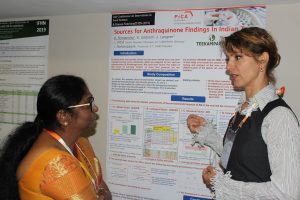Für die zwei o.g. Wirkstoffe soll die europäische Höchstmenge auf die analytische Bestimmungsgrenze herabgesenkt werden. Für Etoxazol fand dies bereits statt, für Bifenazat wird es sehr bald stattfinden. Das heißt auch, dass die beiden Wirkstoffe im Hopfenanbau in der EU nicht mehr…
>> Weiterlesen
Untersuchung von Benzol in Treibgasen
Die PiCA Prüfinstitut Chemische Analytik GmbH bietet nun die Analyse von Benzol CAS-Nr. 71-43-2 in sogenannten Treibgasen (wie Propan, Butan, Isobutan etc.) mittels Headspace GC/MS an. Die Bestimmungsgrenze für diese hochempfindliche Analytik liegt bei 0,1 mg/kg.
Schnelle und zuverlässige Analytik von Ethylenoxid (inkl. 2-Chlorethanol) in Lebensmitteln
Ethylenoxid (EO, Oxiran, CAS Nr.: 75-21-8) wurde in der Vergangenheit als Begasungsmittel (Insektizid) v.a. bei der Lagerung bzw. Transport von Getreide, Samen und Nüssen verwendet. Es wurde auch zusammen mit einem höheren Anteil Kohlendioxid unter den Handelsnamen Cartox und T-Gas als Begasungsmittel…
>> Weiterlesen
Wichtige Information für unsere Kunden – Unser Labor bleibt geöffnet
Die PiCA Prüfinstitut Chemische Analytik GmbH hat wegen der COVID-19 Pandemie zahlreiche interne Maßnahmen getroffen, um eingehende Proben weiterhin termingerecht und in gewohnter Qualität zu bearbeiten. Sollte es in Einzelfällen trotzdem zu Verzögerungen kommen werden Sie rechtzeitig informiert. In der Hoffnung auf…
>> Weiterlesen
Identifizierung von Nikotinquellen in indischem Tee
A. Hofmann, A. Romanotto, K. Speer**, K. Gassert*** **Technische Universität Dresden I Professur für spezielle Lebensmittel-chemie/ Lebensmittelproduktion *** Teekampagne, Potsdam Gewinner des Poster Awards der RAFA 2019 Untersuchungen des Bundesinstituts für Risikobewertung (BfR) im Jahr 2009 haben gezeigt, dass verschiedene pflanzliche Lebensmittel,…
>> Weiterlesen
Target screening of acrylates from UV-curing inks and coatings in food contact material
Ultraviolet (UV) cured coatings show excellent appearance, durability, and little or no volatile organic compound (VOC) emissions, while enabling increased productivity and lower overall costs. An UV-curable coating is one of the best finishing methods in the paper and packaging industries for…
>> Weiterlesen
Sample preparation for multi-residue analysis in difficult matrices with an optimized push-through-SPE
Analytical methods have to be fast and easy and to be able to recover a large number of analytes. The analysis of pesticide residues in spices, herbals, tea or hops is considered difficult due to the complexity of the matrix. With the…
>> Weiterlesen
Sources of Nicotine in dried mushrooms
A discussion about the source of Nicotine (NIC) in boletus (Boletus edulis) was started in the EU in 2009. No clear conclusion about the nicotine source in wild dried mushrooms was reached [1,2]. In 2010 the specific MRL of 2.3 mg/kg for…
>> Weiterlesen
Determination of oxy-PAHs and N-PACs in foodproducts
Polycyclic aromatic hydrocarbons (PAH) are well known contaminants in food. Their mutagenic and carcinogenic effects lead to significant human health risk. [1] However the oxidized form of PAHs (oxy-PAH) and the nitrogen containing polycyclic aromatic compounds (N-PAC) have rarely been researched so…
>> Weiterlesen
PiCA auf der zweiten IFHN-2019 Konferenz in London
Sources for Nicotine and Anthraquinone in Indian Tea A. Romanotto, A. Hoffmann, PiCA GmbH Berlin, Germany K. Gassert, Teekampagne, Potsdam, Germany K. Speer, Technische Universität, Dresden, Germany Introduction: In recent years, tea (camelia sensis, camelia assamica) has been viewed more and more…
>> Weiterlesen

